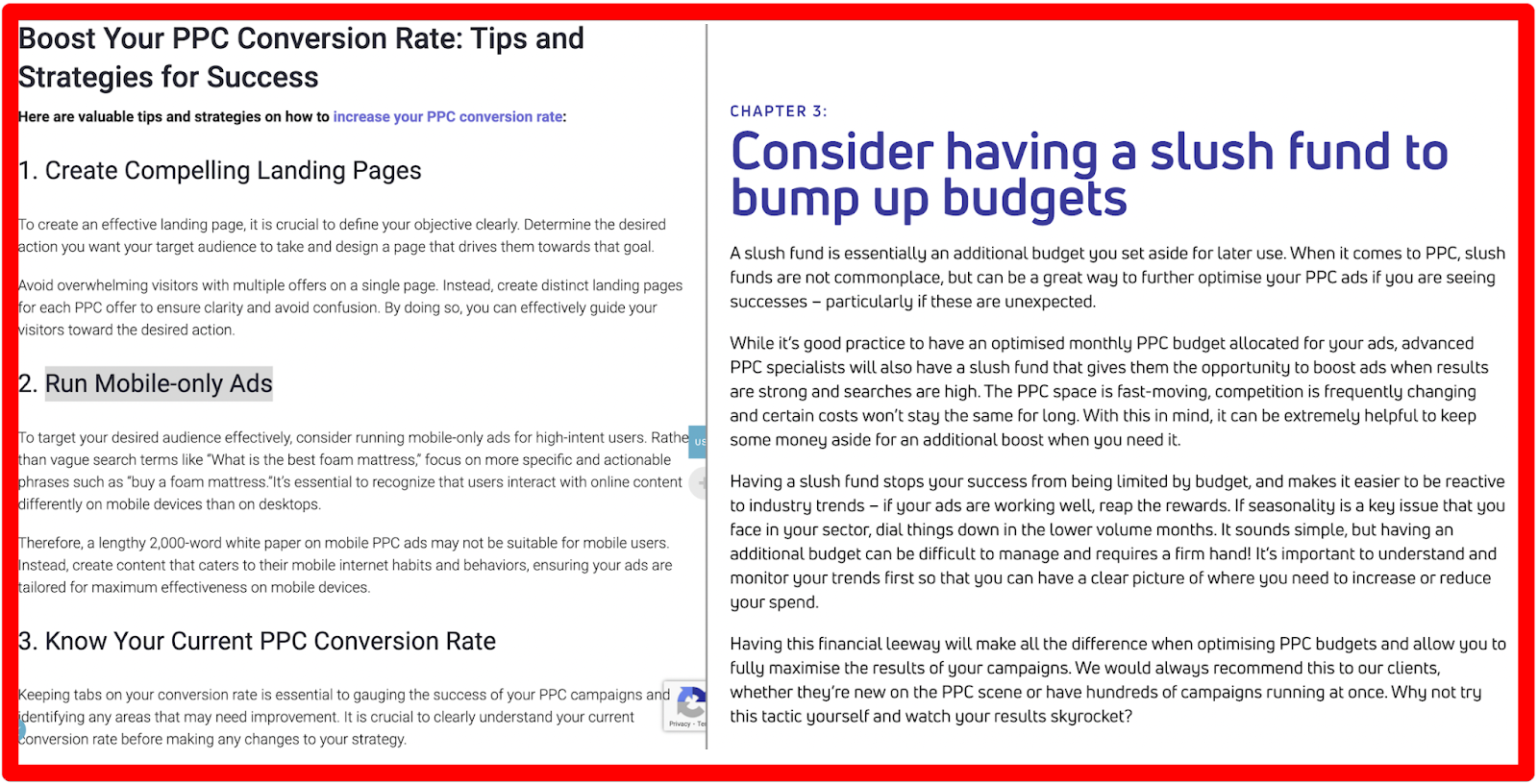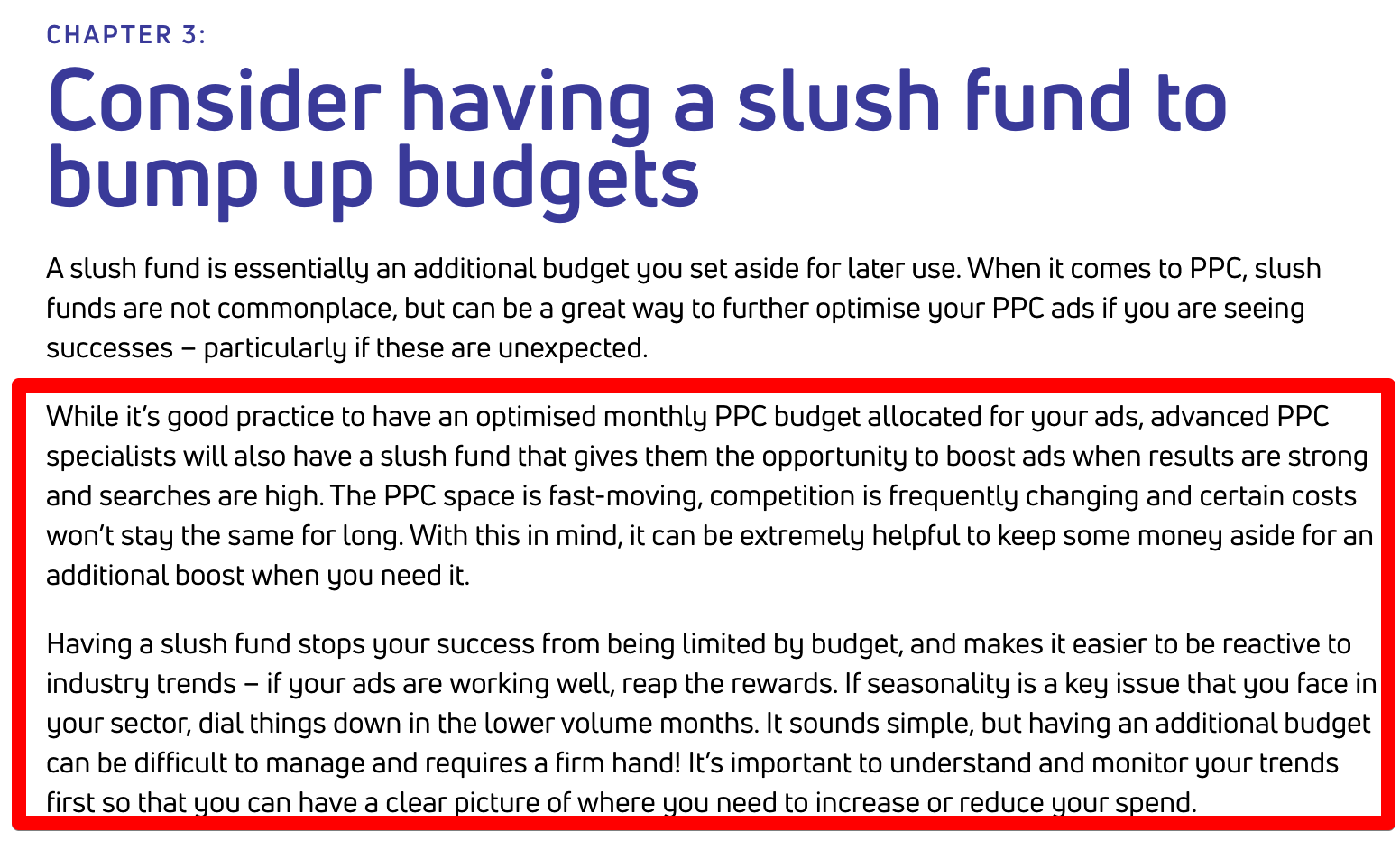What everyone gets wrong about writing unique content + How you can publish unique content at scale
By Yaseen Sadan on February 29, 2024
%20(1).png)
I recently read an article on how to improve PPC conversions and they were saying the most obvious things like:
- Choose the right keywords
- Use Google Analytics
- Add negative keywords
I thought to myself, "That was a waste of time. I learned this 10 years ago when I launched my first campaign. I'm never reading an article by that company again."
This might be an extreme example, but this type of obvious content is published everywhere.
At SaaSpirin, we call this The ChatGPT Writing Strategy. Writers won’t have real-life experience in what they are writing about, so to make up for this, they’ll type the primary keyword they are targeting into Google and regurgitate whatever they find on the first page. It's literally what ChatGPT does.
This ultimately results in companies publishing obvious, beginner-level content while selling to experienced professionals.
If you're employing this strategy, there's a high likelihood that you're publishing obvious content on your website as well.
And this is the main reason why businesses cannot generate organic conversions. They publish content that’s so obvious and surface-level that their target audience bounces after reading a few sentences.
In this guide, we wanted to propose a solution to The ChatGPT Writing Strategy so you can write at your target reader's knowledge level, provide truly unique advice that they never learned about before, and get them to buy your product.
A real-life example of obvious content vs. unique content
Obvious content looks good at first glance because there are no typos, and the sentences read well, but when you dig a little deeper, you find that it's just high-level fluff that's not really saying anything.
To illustrate the difference between obvious and unique content, let's look at these two articles.

Both of these articles target the keyword “improve PPC conversions” and both websites are selling PPC services to other companies. They are trying to get marketers inside these companies to book a call after reading their articles.
Now let's put you in the target reader’s shoes.
You’re a CMO for an enterprise company. You just received more marketing budget and you want to get more conversions through PPC. So you type “improve PPC conversions” into Google, you click on the article on the left, and you see advice like this:
- Know your current PPC conversion rate
- Create compelling landing pages
- Run mobile ads

You already know this. You’re a CMO who has been in the industry for 10+ years. You aren’t looking for lessons that a beginner would learn on day one. You’re looking for advanced, detailed articles that’s going to show you how to improve conversions, so you bounce and search for another article.
You come across the article on the right. When you scroll down, you learn about folding Microsoft Ads into your PPC strategy, building a slush fund to bump up budgets, and using remarketing lists for search ads (RLSAs).

Many of these topics are new to you, so you continue reading and by the end of the post, you think to yourself:
“Wow, I never heard about these PPC strategies before, this is amazing! These guys really know what they are talking about.”
You find out that this company offers PPC management services, and since you’re looking to increase your company’s PPC conversion rate, you hop on a call with them to learn more about their processes.
See how publishing unique content can be the difference between getting a reader to convert or having them bounce and never read your blog again?
Readers make buying decisions based on how detailed and non-obvious your content is; they don’t want to read about things they learned 10 years ago.
So if you’re publishing obvious content, you’re turning away thousands of readers who might be interested in buying your product.
What causes obvious content?
We believe the major mistake companies make when writing content is that they hire writers who don’t have first-hand experience in the topic they are writing about.
Think about it: If your target readers are CMOs at enterprise companies, how can a writer with zero marketing experience write an article that’s going to impress them?
To compensate for this lack of experience/knowledge, the writer types the primary keyword they're targeting into Google and regurgitates the information they find on the first page. They’ll then use an SEO tool to optimize their keyword placement and call it a day.
Since 95 percent of the articles on the internet are already obvious, beginner-level fluff, writers write far below the knowledge level of CMOs, causing a drought in organic conversions.
How to avoid publishing obvious content
There are two things you can do to stop publishing obvious content on your website:
- Hire writers with actual experience in your industry
- Have your writers interview industry experts
1. Hire writers with actual experience in your industry
The easiest way to write unique content is to have a writer with industry experience write articles for you. You could also write your own articles by sharing the lessons you learned over the years.
This alone sets your content apart from 95 percent of content on the internet because you aren't regurgitating existing articles. You're using your own expertise (or the writer's expertise) to give advice that experienced professionals can learn from.
This means:
- If you're writing about PPC ads, hire writers who have real-life experience running PPC campaigns for their own businesses or their clients' businesses.
- If you're writing about software development, hire writers who held software development jobs for multiple years and have actually built software themselves.
- If you're writing about artificial intelligence, hire writers who worked with large language models and developed and tested AI algorithms.
You get the idea.
If you hire writers without experience in the topic you're writing about, it’s going to be almost impossible to publish unique content that your target reader finds valuable. The writer will likely regurgitate what they find on the first page of Google to make up for their inexperience, resulting in surface-level, obvious content.
However, this presents a problem. It's very difficult to find writers who have 10+ years of experience in a specific industry. These professionals hold senior positions in companies; they aren’t writing content.
Also, your in-house team of PPC managers, software developers, or AI engineers probably doesn't have the time to sit down and write a 2000+ word article. This makes it difficult to scale content creation, which is why we're proposing the second solution.
2. Have your writers interview industry experts
If you can't find writers with several years of industry experience, have your writers conduct interviews with industry experts and base each article around these interviews.
At SaaSpirin, we'll have our writers conduct interviews with various team leaders inside our client's company, i.e. the CEO, CMO, head of sales, or head of product development.
This allows us to dive deep into the specific problems our client’s customer is facing and suggest detailed, step-by-step solutions that can help them solve these problems.
The entire interview-based writing process looks something like this:
- Identify common pain points: Before we begin interviewing industry experts, we’ll interview our client’s customers and get an idea of what challenges/pain points they are facing.
- Use these pain points to develop topic ideas: Once we have a list of common problems, we’ll write an article around each problem. These customer problems will become the foundation of our SEO strategy. So instead of choosing topics randomly, we’re writing articles that address problems our client’s customers/prospects are actually facing.
- Interview the person inside the organization with the most expertise in that subject: Depending on what our article is about, we’ll interview a different person within our client’s organization. If we’re writing an article on how to write better ad headlines, we’ll interview the senior copywriter. Or, if we’re writing an article on launching new software products, we'll interview the CTO.
- Come up with questions to ask: Alongside your freelance writers, come up with questions that'll get the interviewee talking about problems customers are facing or common mistakes customers are making. Asking the right questions will allow your interviewee to talk about the topic in great detail, ensuring you have enough material to write an article that can be considered unique content.
- Use this information to write the article: It should be quite straightforward to differentiate your content from the competition because you can use the ideas and advice you learned about in the interview inside your article.
- Send the article back to the expert: Before you publish the article, send it back to the expert and ask them if your article will actually benefit them. In most cases, the expert will flush out some fluff and obvious statements that may have crept in, but overall, if you did steps one to five correctly, your unique content should be ready to publish.
Take your website to 10K monthly traffic within the next 12 months
We're SaaSpirin, a SaaS SEO agency and we take pride in the content we publish. We never regurgitate what we find online, we always interview clients to uncover truly unique advice we can share with their audience.
This allows us to take brand new websites to 10K monthly traffic fairly quickly and generate reliable conversions along the way.
Here's a brief overview of how our SEO strategy works:
We run keyword gap analysis: We begin by identifying keywords your top three competitors are ranking for and you aren’t. This results in a bunch of keywords you have the potential to rank for in the next couple of months.
We write interview-based articles: We’ll then interview people inside your team to understand why customers buy your product, what features customers use most, and what differentiates your product from the competition. This results in an article that targets pain points your customers resonate with.
We track conversions inside Google Analytics: We’ll also ask for access to your Google Analytics account, where we’ll set up conversion tracking so we can get an idea of where product sign-ups are coming from.
We build backlinks to the highest-converting articles: The last step involves building backlinks to the articles that convert best. This active backlink building allows these articles to rank higher and generate more high-intent traffic, thus, more conversions.
If you’re interested in learning more about this process or you’d like us to take care of your content marketing/SEO for you, consider booking a quick discovery call with our founder.
You May Also Like
These Related Stories

The Content Offer - How to Use Upgrades to Increase Email Signups

Hiring a Content Agency vs Your Own Writer
.png)
